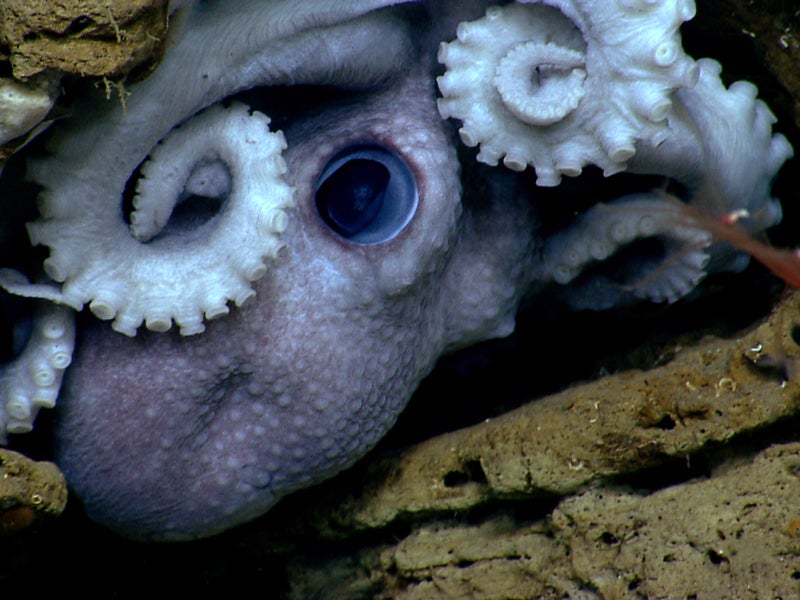A Monumental Opportunity for Ocean Protection
Members of the public are urging President Obama to protect New England’s Caches Ledge and “Grand Canyons” and seamounts by declaring them a National Marine Monument.

This page was published 10 years ago. Find the latest on Earthjustice’s work.
On September 2, the New England Aquarium held an event to raise awareness about the unique beauty and scientific significance of two one-of-a-kind places off of New England’s coast: Cashes Ledge and New England’s “Grand Canyons” and seamounts.
An enthusiastic crowd of over 600 attended from all walks of life, including fishermen, divers, educators, local business owners, tribal representatives, scientists, members of the faith community, environmental activists and many members of the public. The crowd urged President Obama to designate these special places, collectively, as the Atlantic Coast’s first National Marine Monument.
Cashes Ledge is an undersea mountain range only 80 miles southeast of Portland, Maine. It rises from basins hundreds of feet deep to its highest peak, known as Ammen Rock, within 40 feet of the ocean’s surface. Along the slopes and ridges of Ammen Rock grows the largest cold-water kelp forest on the Atlantic seaboard.
Further offshore, about 150 miles southeast of Cape Cod, lay the Grand Canyons of New England. Flanked by undersea mountains that soar thousands of feet from the ocean floor, this area is a unique world filled with vivid cold-water corals, many of which are hundreds of years old. Marine ecologist Peter Auster of the Mystic Aquarium, who has conducted research dives at the canyons and seamounts for over 30 years, described the deep-sea corals that sometimes grow to the size of small trees as “a veritable Dr. Seuss garden.”
These areas are not just beautiful; they are also essential to the health of the Gulf of Maine and the northwest Atlantic Ocean. The rich and biodiverse undersea gardens of Cashes Ledge nourish an incredible array of marine life—from tiny plankton to endangered right whales—that are necessary to a healthy ocean ecosystem and that help form the fabric of New England’s coastal life. Similarly, New England’s coral canyons and seamounts provide food, spawning habitat and shelter for a wide variety of fish and crustaceans, and the waters above teem with life, including large fish like tuna and billfish, sea turtles, seabirds and what may be the highest diversity of whales, dolphins and porpoises in the North Atlantic, including the iconic sperm whale.
New England’s Grand Canyons and seamounts and Cashes Ledge are national treasures. Scientists say they offer rare examples of how marine life once thrived throughout New England’s waters, and agree their ecosystems are part of the answer to restoring depleted fisheries and buffering our ocean from changes caused by global warming.
Unfortunately, these fragile undersea places face new threats from overfishing and industrial exploitation, as the deep ocean has become more accessible to commercial fishing, drilling and mining. We have a narrow window of time to protect them, and we need to act now. President Obama needs to designate these pristine undersea mountain and canyon ranges as a Marine National Monument in order to safeguard them from industrial activity that could ruin them forever. As the nation with the largest exclusive economic zone in the world, the United States has a tremendous opportunity and responsibility to be a global leader in protecting our oceans.
On September 15, the National Oceanic and Atmospheric Administration hosted a town hall meeting in Providence, Rhode Island, to discuss permanent protections for three deep-sea canyons—Oceanographer, Gilbert and Lydonia Canyons—and the four seamounts off of New England’s coast. While protecting these areas would be welcome, it would also be incomplete. We must protect all five offshore Grand Canyons, including Nygren and Heezen, and New England’s unique nearshore mountain range, the Cashes Ledge Closed Area. We need to save all of these important places so our children and grandchildren can enjoy a healthy marine environment.
President Obama has the authority to designate a monument under the Antiquities Act. This authority has been used by presidents from both parties to protect our natural and cultural treasures. The enthusiasm expressed at the New England Aquarium and in tens of thousands of letters that have poured into the White House show that the president has public backing to make the designation as well. The initial deadline for public comments on the monument designation was September 15, but following an outpouring of support, the National Oceanic and Atmospheric Administration has extended it for several more weeks.
Establishing Cashes Ledge and the coral canyons and seamounts as a marine monument would help restore New England’s oceans. Important New England fish stocks, such as Atlantic cod, are in a state of collapse, and warming waters are threatening marine ecosystems. We must act with courage to protect habitats like these to help bring back fish populations and to build resilience to the effects of climate change. A marine monument will benefit not just the species in the ocean, but also New England’s coastal communities that depend upon a healthy ocean. This is a monumental opportunity for ocean protection.
Earthjustice’s Oceans Program uses the power of the law to safeguard imperiled marine life, reform fisheries management, stop the expansion of offshore oil and gas drilling, and increase the resiliency of ocean ecosystems to climate change.